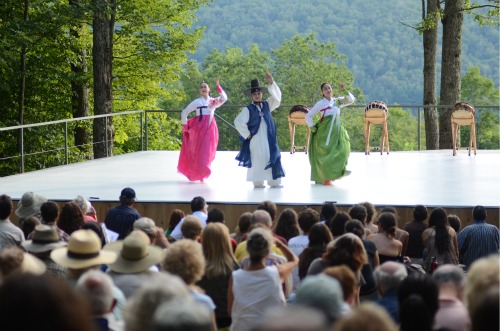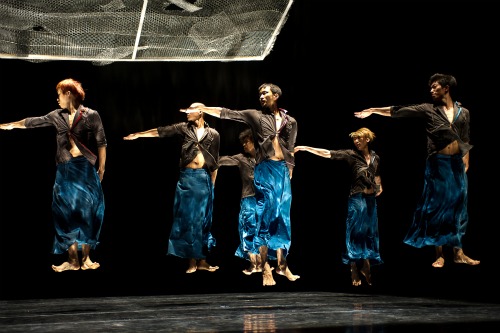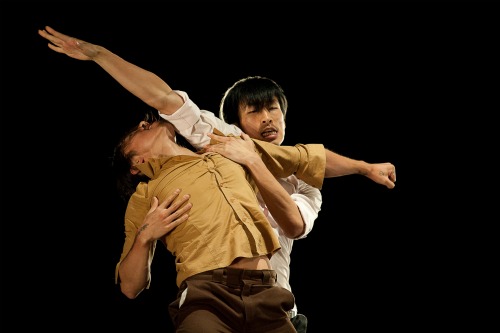Fifteen years ago, I decided that the Korean salpuri was one of the world’s great dances. For some time, smitten by a performance in an early black and white film, I had corralled graduate students from Korea to perform a salpurifor the dance history class I taught. They managed it with varying degrees of skill and spirituality. Then, in 1996, in Seoul, I saw a version of this solo (which derives from a shaman ritual) danced by a small, quite aged woman with the status—as I remember—of a Living National Treasure. That was the clincher.
The members of the Korean Traditional Music and Dance Institute of New York who performed during “Korea Week” on Jacob’s Pillow’s outdoor stage didn’t offer a salpuri, but their Huhteun Choom (Improvisation Dance), choreographed by Lee Jo Lim, evoked all that fascinates me about Korea’s varied traditional forms. This piece—performed with beautiful gravity by two women and a man (Yusun Kang, Hosun Kang, and JiHwan Choi) —is not in the raucous style you see in Korean masked dance-theater and some folk dances. Like the salpuri, it’s refined, slow-moving, inwardly focused. Small, startling dynamic shifts punctuate the movement’s flow. The performers move their arms with a gentle fluidity, then suddenly flick their hands up. They walk smoothly, rise onto their tiptoes, then bend their knees and sink with a decisive move that has the effect of a quick exhalation.
Both the dancing and the music that accompanies it (taped but with live percussion) are unafraid of suspended pauses. Time slows. The movement sighs again into its serene rise and fall. The setting sun glimmers through the two women’s diaphanous, high-waisted hanboks, Preparing to walk or turn, they hike up the fabric of these traditional costumes with a swift little gesture and slide out a foot, raising the toe of one white fabric slipper off the ground; it’s a step you could fall in love with.
KTMDI’s performance preceded the one running from July 27 through 31 in the Pillow’s Ted Shawn Theatre. You could assume from the slant of the publicity and the pre-curtain speech given by the Pillow’s director, Ella Baff, that the South Korean, all male, LDP/Laboratory Dance Project was going to show you dancers shot from guns in a melee of hip-hop, acrobatics, modern dance, and martial arts. And, for sure, the closing piece on the program, No Comment (2002), choreographed by the company director and performer, Chang Ho Shin, erupts into a barrage of backflips; spread-eagled, spinning leaps; and dives to the floor.
However, although choreographer-performer Insoo Lee and dancer SunTae Lee began as street dancers and won hip-hop competitions, all eight men have BAs from the Korean National University of the Arts School of Dance and six have MAs as well. In other words, these guys are hip to popular culture but also to traditional forms and western mainstream and experimental styles. The dances that the company brought to its U.S. debut are sophisticated, edgy, and very, very interesting.
I thought, too, that I could see a shadowy link to Korea’s more traditional forms. This idea emerged from a certain reticence on the part of the dancers and a subtle downplaying of virtuosity, as well as from the elegant rhythmic interplay in much of the choreography. The three LPD works on view at the Pillow create contrast by juxtaposing highly energetic dancing with sudden momentary arrests; or watchful pauses; or casual, walk-away-from-it behavior.
In Are You Happy To See Me? (2005) by a woman choreographer, Mi Sook Jeon, six of the men wear identical costumes by Kwan Yoon that channel both contemporary fashion and ancient attire: long, slightly flared blue skirts and loose brown jackets fastened by one button. The clothes swing in the tide of movement. The set by Jun Kim—a tilted, four-paned “window” barricaded by mesh and suspended more or less horizontally overhead—hints at restriction; so do the rectangles and squares of light that designer Jung Wha Kim lays on the floor.
In the beginning, and again at the end, Dongkyu Kim is alone downstage left —an outsider, perhaps—while on the right side of the stage Hwansoon Jeon, Kihun Kim, Sung Hoon Kim, and SunTae Lee begin the arm movements and kicks that dominate the movement palette. The emphasis is on strength and precision, but not all of the men’s moves take up a lot of space; one looks like a particularly vigorous shaking of dice.
Choreographer Jeon manipulates and varies the spatial patterns and interactions between the men with skill. There are moments of contact. Dongkyu Kim lifts Shim, drops him, and drags him along (the latter performs a brilliantly slippery, resilient solo). Grabbing hands in shifting pairs, the men create rapidly changing archways for one another to run under, just as the music changes gears (the selections are “Vaihtovirta” and “Johto3” by the Finnish group Pan Sonic, arranged by Youngkyu Jang). They play what seem to be games or strange pastimes—racing, falling on their backs, and being helped up; shaking vigorously; advancing on the audience in a line. And with all this, they find time to walk around and, apparently, think. A mysterious piece, and a compelling one.
The most recent work on the program is Insoo Lee’s 2008 Modern Feeling, a duet for himself and Jinyook Ryu—that contains as much astute acting as dancing. Two chairs. Two men. Ryu is seated, brooding, chin on hand. Lee walks in. No reaction from Ryu. Lee sits, makes a tentative gesture toward Ryu, thinks better of it. Then he places a hand on Ryu’s thigh. Immediately that leg commences to shake, causing Lee’s hand to shake too. They try this some more Lee giggles.. Then they both think. Then Lee sits on Ryu’s lap. For a second.
This is the kind of rhythm that develops. The men embark on various strategies that could be competitive. At one point, Lee and Ryu get literally wrapped up in each other. For a while, Lee goes all floppy. Music attributed to The Methis Works plus the British group Portishead’s “Nylon Smile” adds the voices of two different women singers and a jangled romantic tone to the danced encounters. There are indications of anger, of starting to leave, but not leaving. Ryu holds out a hand; Lee knocks him down. They go in for a bit of martial arts. They go to a corner and look up, puzzled. One chases the other in a very fast walk around the stage.
There’s a point at which I think, “that’s enough,” but the men go a little past that moment to dance side by side. In the end they come downstage and a new light falls past them onto the spectators in the first two rows. The guys look at them and laugh. What’s not to love?
The choreography on this program avoids most of the clichés of machismo, such as swaggering bravado, or rough “do that again and I’ll kill you” and “I love you, buddy” stuff (although in Modern Feelings, Ryu and Lee do one of those body bumps in the air that we’ve been seeing in modern dance since the 1970s). The closing No Comment has plenty of fireworks—not all of them hip-hop standards—as well as a lot of emphatic stamping, but the dance also shows us that the men in this group have a variety of ideas about dancing and performing that go beyond the obvious.
That stamping is one of the first sounds we hear before the lights come on for No Comment, as well as a slapping sound we can’t quite identify. It turns out to come from one man (Shin), who has pushed his hand up under his shirt and is smacking his chest hard. He keeps doing this, while Sung Hoon Kim repeatedly whirls himself into the air and down into a seated position or jumps and lands sitting on his heels (hip-hop chops used for expressive purposes). Later, all eight men bang out those magnified heartbeats.
The music is by Goran Berovic, as well as the British fusion group Transglobal Underground. At one point we hear a ululating female voice; at another, what could be a Balkan men’s chorus. Heavy-duty percussion counters the men’s stamping and slapping.
No Comment may simply be about these terrific men sweating together to perform a gladly undertaken ordeal. Off come the colorful jackets they’re wearing; off come the shirts. At the end, they begin advancing toward us in a wave of dancing, retreating, advancing again…
The big, knock-yourself-out movement looks like a lot more than the sum of its influences.




You know Judy Van Zile’s book, Perspectives on Korean Dance?
I’m grateful to Barbara Palfy for mentioning Judy Van Zile’s excellent book.
Deborah, so many of us treasure your writing and are pleased to be able to continue to make discoveries with you.
LPD/Labarotory performed the same show in Portland last season, preceded by the same kind of hype Deborah describes above. My impressions were the same, although nothing like as informed as hers; what I know about classical Korean dance is miniscule, but I suspect I would like it. The audience here was thoroughly energized by the last piece, I would add, and I felt just a bit manipulated. I would add that it makes me queasy to think about a woman making work on a company that would exclude her from dancing, as interesting as I found it.
Martha’s comment about a woman choreographer creating a work for an all-male company made me realize that I left out a piece of information about Mi Sook Jeon’s relation to the members of LDP. She is not only a prominent Korean choreographer, she is a Dean of the Korean National University of the Arts, and all the men in question studied with her. In other words, they’re her guys. It seems natural to me that both she and LDP would collaborate.
I would have loved to see that dry old woman do a ritual dance.
Hello Debora
This is Yusun & Hosun. We were the performers for JacobPillow Outstage “Korea Week”.
Thank you so much for reviewing our performances.
We truly appreciate your comments. We love to share Korean dance with non-Korean communities.
We’d love to invite you to our future performances to share more!!!
Wonderfully well written blog post!!!
I am looking for Korean Folk Dancing as the special entertainment for the Official Visit to my District by California Department American Legion Auxiliary. Would you how I can go about searching for a dance troop in California?